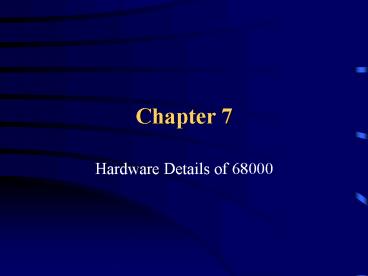Hardware Details of 68000 - PowerPoint PPT Presentation
1 / 11
Title: Hardware Details of 68000
1
Chapter 7
- Hardware Details of 68000
2
BASIC PIN DISTRIBUTATION
- 64 Pins
- Communicates with outside world with 16 bit
bi-directional data-bus. - 24-bit address bus
- Control Signals
- 3 Interrupt Lines for Hardware Interrupt
- Three Control output for interfacing peripherals
- Clock speed of 4 to 16 MHz.
3
CPU PIN DESCRIPTION
- Vcc, GND, CLK
- Processor power and clock inputs
- There are two pins for each Vcc and GND.
- Roughly 300mA is required as supply current.
- For clock rise and fall times are limited to
10nsec - The clock waveform must be a TTL compatible of
50 duty cycle. - Crystal oscillator is used for stable clock
frequency.
4
FC0, FC1, FC2
- Encoded processor state.
- Indicates the current internal processing state
of 68000. - The function code outputs are only valid when
the processors AS signal is active. - Prcessing states are divided into user data, user
program, supervisor data, supervisor program, and
interrupt acknowledge. - 74LS318 can be used as the decoder.
5
E, VMA, and VPA
- To control the older 68000 peripherals.
- These signals facilitates the designer to
translate their design from 8-bit upto 16-bit
designs. - E Clock is used for the proper timing signals for
6800 peripherals - It is derived from 68000 clock by dividing by 10
- Valid peripheral address input is used to inform
the 68000 that it has the addressed a 6800
peripheral and the data transfer should be
synchronized. - Valid Memory Access output indicates the above
synchronization. - It goes low when processor synchronizes with E
clock.
6
Synchronization Sequence
- The 68000 output the address of a 6800 peripheral
on A1 through A23. - The peripheral circuitry responds by pulling VPA
low. - When synchronization is achieved it is indicated
by pulling VMA low. - Then Data transfer takes place.
7
RESET HALT BERR
- Used for system Control.
- BERR input is used to inform the processor that
the cycle currently executing has a problem and
it should take appropriate action. - Processor has addressed an illegal memory
location. - Other kind of bus error has occurred.
- The 68000 chose between
- Performing bus error exception
- Returning bus cycle
- If HALT line is not asserted when the bus error
occurs, the 68000 start bus error exception
processing., terminating the currently failed
cycle. - If the HALT line was asserted before or at the
same time as the BERR signal, the 68000 will
rerun the bus cycle. - It does this by terminating the cycle and placing
the data and address bus in high-impedance state. - The 6800 the enters a Do Nothing state until
there is activity on HALT. - When HALT line is deactivated the processor will
rerun the previous cycle.
8
IPL0 IPL1 IPL2
- This is used for Priority level of the Interrupt
control - Level 7 has the highest priority
- Level 0 has the lowest priority
9
BR, BG, and BGACK
- Used for Bus Arbitration Control
- The requesting device called the bus master
requests use of the 68000s busses by activating
BR input. - The 68000 will respond to its request by taking
BG output low indicating that it will release
control of the busses at the end o the current
cycle. - When another master wants to take control it
asserts BGACK (Bus Acknowledge) - Steps must be taken care before asserting BGACK
- BG must be active
- AS must be inactive, to show that the processor
is not using the bus - DTACK must be inactive, to show no external
devices are using the bus - BGACK must be inactive to ensure that no other
bus master is using the bus
10
AS, R/W, UDS, LDS DTACK
- Asynchronous Bus Control
- Address Strobe is used to indicate is valid
memory address exists on the address bus. - Read/Write determines if the current cycle is
read or write. - Upper/Lower Data Strobe is used to for
transferring the 8-bit of data. - Data Transfer Acknowledge is used by external
circuitry to perform asynchronous data transfer. - It is the job if the external hardware to
activate or deactivate this signal at proper
times.
11
SYSTEM TIMING DIAGRAMS































